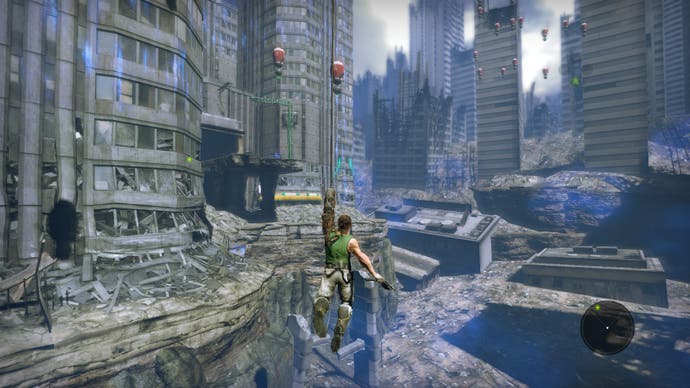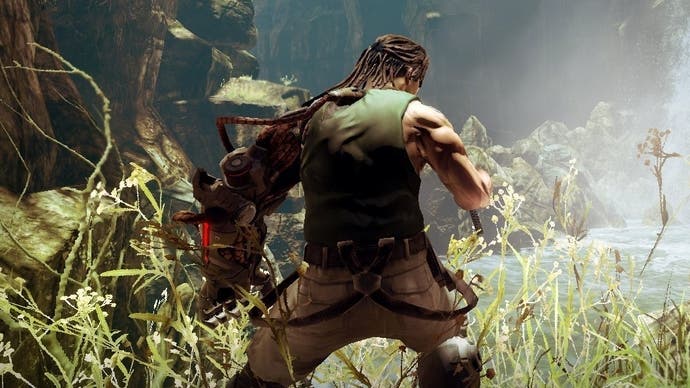The Double-A Team: their lives are in your hands - and your wife is in your arm - in Bionic Commando
Rad.
The Double-A Team is a new feature series honouring the unpretentious, mid-budget, gimmicky commercial action games that no-one seems to make any more.
Last week, Oli Welsh explored the hokey canine charms of Dead to Rights. Today we're taking to the skies with Bionic Commando.
At the core of it all is a perfect bit of animation. It's the leap that sells this game, the leap of faith. Off the edge of a staircase or out through a hole knocked in a wall, out, out into the open air. Arms reaching, chest forward, hurtling to the ground. And then the hook sizzles and rushes and clamps on and the line goes tight and you're yanked in a new direction. Onwards! Upwards!
Grappling hooks are a wonderful bit of wish-fulfilment - an ideal tool for any video game that wants to make your wilder fantasies of traversal come true. Who doesn't want to move faster, leap higher, zip around from here to there? Who doesn't look up in the bright cities of the world at all those towers rising overhead and feel a little sad that the vertical wonders of modern space are pretty much closed off to most of us?
Capcom's 2009 reimagining of Bionic Commando had a lot of tricky stuff to overcome. There was the spectre of a legendary 8-bit original, all that woozy nostalgia to be compared to unfavourably. Then there was one of the silliest plot twists in all of video game history involving a missing wife and a prosthetic arm. Then, and I suspect I am right about this, there was a limited budget. There must have been, because Bionic Commando has to make so much of its fun out of simple ideas repeated with simple variations, butter, as Bilbo once put it, scraped over too much bread. But none of this really mattered, because at the core of it all is that perfect bit of animation: the leap, the swing, the body carving through the sky. Onwards!

Bionic Commando casts you as a super-soldier of some kind - you work for the FSA, which is presumably not the Financial Services Authority or even the Food Standards Agency - sent into a recently irradiated city on a mission to.. to... To be honest, I've never really paid this part much attention. The important thing is that you're the kind of super soldier who comes with a bionic arm, and the arm in question is a grappling hook that allows you to swing about the city, moving from one overhanging twill of rebar to the next.
Freedom! But because this is 2009, that freedom comes at a bit of a price. Or does it? Bionic Commando is a reminder that the last few years in games have often been about automation: taking something complicated and making it feel simple. Just Cause gives you a grappling hook but it's a doddle to use. Marvel's Spider-Man channels the pitch-perfect web-swinging of Spider-Man 2, but somehow it's become something my five-year-old was able to pick up and master in a matter of seconds.
Bionic Commando is different. You need to really pay attention. Your super soldier is capable of grace and poise as he arcs and hops through the city, but you need to learn your way towards that state. Hold down the trigger to extend the grapple when a grappleable point becomes available. Release it to let go. More importantly, watch for two little blue dashes on the screen that tell you the optimal moment to release, the moment when you've picked up the most momentum and will be able to travel to the next grapple point with little trouble.

Games can locate their character all over the place, I guess. Bionic Commando's character - its individual flavour - can be found here, as you learn to judge the best moment to release the grapel and risk a quick untethered journey through the air. Then, the new connection, that sense of being arrested in motion, yanked in a new direction. It's traversal, but it never ceases to be an event. When you get good at it, you really feel like you've learned to do something. You feel like you've picked up an actual skill, rather than the candy-coated skills that are handed out in the upgrade menus of other games, or tossed your way every now and then for levelling up. Combining it with the other basic move of reeling in the attached hook and then hopping upwards onto a new ledge, and there is real elegance of movement available if you put the time in.
Enter weapons, which come with very small ammo clips, and special moves, many of which are genuinely special. I love the ground-pound as you drop through the streets and shatter the earth beneath you. I love the moment you learn to boot a forklift into the air and then blast it into a distant foe. There are fleeting instances of forward-thinking here too. I sense a bit of Vanquish in the mix every time I pull off the zip-kick move that ends by spinning you backwards into the air. In some of the combat scenarios, as you zip around above your foes, separating them and picking them off one by one, there's a touch of Arkham, which, actually, now I've just Googled it, came out the very same year, 2009.

It all works because the environments support it, I think: Bionic Commando does a great job at linear dereliction, offering cityscapes and wilder spaces that seem open but which actually channel you pretty tightly. I can even forgive the clouds of radiation that prod you back in the right direction because the linearity the game's aiming for still includes room for personal flair.
And it works because, like many Double-A games, Bionic Commando is trying to do one thing well. The gunplay's alright, the missions are sort of okay and the sense of place is a bit pencilly, but just as Dead to Rights let you launch your dog at crims until the cows came home, Bionic Commando never tires of giving you an avenue to swing around and a bunch of high ledges to launch yourself from. Just so long as you're willing to put in the time to make it all work, obviously.









